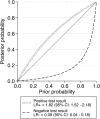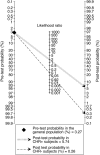At risk or not at risk? A meta-analysis of the prognostic accuracy of psychometric interviews for psychosis prediction
- PMID: 26407788
- PMCID: PMC4592655
- DOI: 10.1002/wps.20250
At risk or not at risk? A meta-analysis of the prognostic accuracy of psychometric interviews for psychosis prediction
Abstract
An accurate detection of individuals at clinical high risk (CHR) for psychosis is a prerequisite for effective preventive interventions. Several psychometric interviews are available, but their prognostic accuracy is unknown. We conducted a prognostic accuracy meta-analysis of psychometric interviews used to examine referrals to high risk services. The index test was an established CHR psychometric instrument used to identify subjects with and without CHR (CHR+ and CHR-). The reference index was psychosis onset over time in both CHR+ and CHR- subjects. Data were analyzed with MIDAS (STATA13). Area under the curve (AUC), summary receiver operating characteristic curves, quality assessment, likelihood ratios, Fagan's nomogram and probability modified plots were computed. Eleven independent studies were included, with a total of 2,519 help-seeking, predominately adult subjects (CHR+: N=1,359; CHR-: N=1,160) referred to high risk services. The mean follow-up duration was 38 months. The AUC was excellent (0.90; 95% CI: 0.87-0.93), and comparable to other tests in preventive medicine, suggesting clinical utility in subjects referred to high risk services. Meta-regression analyses revealed an effect for exposure to antipsychotics and no effects for type of instrument, age, gender, follow-up time, sample size, quality assessment, proportion of CHR+ subjects in the total sample. Fagan's nomogram indicated a low positive predictive value (5.74%) in the general non-help-seeking population. Albeit the clear need to further improve prediction of psychosis, these findings support the use of psychometric prognostic interviews for CHR as clinical tools for an indicated prevention in subjects seeking help at high risk services worldwide.
Keywords: Psychosis; high risk services; prevention; prognostic accuracy; psychometric interviews.
© 2015 World Psychiatric Association.
Figures



References
-
- Insel TR. Rethinking schizophrenia. Nature. 2010;468:187–93. - PubMed
-
- McGorry PD. Early clinical phenotypes, clinical staging, and strategic biomarker research: building blocks for personalized psychiatry. Biol Psychiatry. 2013;74:394–5. - PubMed
-
- Arbyn M, Verdoodt F, Snijders P, et al. Accuracy of human papillomavirus testing on self-collected versus clinician-collected samples: a meta-analysis. Lancet Oncol. 2014;15:172–83. - PubMed
-
- Michel C, Schultze-Lutter F, Schimmelmann BG. Screening instruments in child and adolescent psychiatry: general and methodological considerations. Eur Child Adolesc Psychiatry. 2014;23:725–7. - PubMed
Grants and funding
LinkOut - more resources
Full Text Sources
Other Literature Sources

